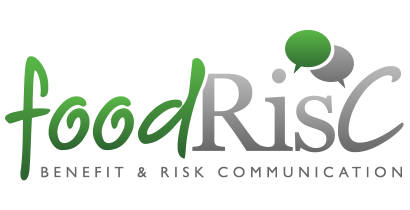Evaluating perceptions and communication of food risks and benefits across Europe
Last Updated : 01 August 2010Consumers are constantly faced with new information regarding the health and safety of their food. However, recent evidence suggests consumers remain concerned over their food supply. Understanding current barriers to communicating the risks and benefits of food and identifying potential remedies for such challenges are the objectives of the European Commission-funded project FoodRisC. This project seeks to produce a practical toolkit that enables effective and balanced food risk communication.
Introducing FoodRisC
Balanced food risk communication remains a challenge across the European Union (EU), with on-going public concern about food supply contaminants, technological advancements, and diet-related diseases (e.g., diabetes and obesity).1,2 Multiple information sources with different perspectives further consumer confusion and the potential for misinformation or misinterpretation.3 Enormous progress has been made in understanding the determinants of consumer risk perception and in identifying effective food risk communication strategies, but such progress has not been matched by appropriate strategies and tools to deliver the information.
The European Commission-funded project Food Risk Communication – Perceptions and communication of food risks/benefits across Europe (FoodRisC) seeks to address such communication challenges by characterising key food risk and benefit relationships, exploring the potential of new social media, and providing a systematic understanding of how consumers deal with food risk and benefit information. The FoodRisC consortium is comprised of experts in key fields relevant to food risk and benefit communication from research institutes, consumer organisations, and SMEs in ten EU Member States. The consortium is supported by an Advisory Board of representatives from eight renowned organisations in health communication (including the European Food Safety Authority, the World Health Organization, and Google) and coordinated by Professor Patrick Wall of University College Dublin’s School of Public Health and Population Science. The FoodRisC project’s ultimate goal is to produce a toolkit and practical guidance that target and tailor coherent food risk and benefit messages to consumers across Europe.
FoodRisC Objectives & Methods
The FoodRisC project has four major objectives:
- Describe key configurations of food risk and benefit relationships and the implications for communicators.
- Explore the potential of new social media (e.g., blogs and social networks, such as Facebook and Twitter) and provide guidance on how risk communicators can best use these media for food risk and benefit communication.
- Characterise the ways in which consumers attain, interpret, and utilise information to help target populations and tailor messages.
- Propose a strategy and communication toolkit for the effective communication of coherent messages across EU Member States.
These objectives will be met through a range of research approaches and methods that extend the traditional framework of food risk and benefit communication. Traditionally, the food communication framework relays information from an authoritative source through a classical media channel (e.g., television, internet, print) to consumers. The FoodRisC project adapts the traditional communication model to include the active role of recipients of the information, and incorporates the way in which various demographic variables (e.g., gender, socioeconomic status, age) serve as barriers to consumer understanding. FoodRisC will also build on the findings of other EU projects including Beneris (Benefit-Risk Assessment for Food: an Iterative Value-of-Information Approach), Qalibra (Quality of life - integrated benefit and risk analysis), PASSCLAIM (Process for the Assessment of Scientific Support for Claims on Foods) and BRAFO (Risk-Benefit Analysis of Foods).
What’s New? Novelty of FoodRisC
Over the last 15 years, there has been extensive research into risk perception and communication across a range of scientific disciplines with recent research highlighting the importance of considering consumer perception of risks and benefits.4 However, little research has been done to develop and implement communication tools that overcome the demographic challenges in consumer understanding of food risks and benefits.
Accordingly, the FoodRisC project is novel in seeking to not only identify the barriers to effective, balanced food risk and benefit communication, but to discover new approaches to overcoming such barriers including the potential of social media, the use of tailored messaging, and the standardisation of key food risk and benefit configurations. In addition, the project is not limited to ‘food scares’, which often garner media attention, but moreover FoodRisC focuses on everyday examples of food-related communications that more directly impact the lives of consumers.
What’s the goal? Impact of FoodRisC
FoodRisC seeks a European level impact with the development of the FoodRisC toolkit together with practical guidance to enable the effective communication of coherent messages across EU Member States. The toolkit will integrate information gathered on barriers to consumer understanding with novel approaches to overcoming such barriers.
EUFIC serves as both a research and dissemination partner seeking to research and provide a systematic understanding of how consumers deal with food risk/benefit information. The FoodRisC toolkit in conjunction with effective dissemination and training will directly improve the current practice of food communication among national and international policy groups while ultimately advancing EU health initiatives.
Further information
FoodRisC receives research funding from the European Commission’s 7th Framework Programme, contract n° 245124.
EUFIC Review - An Introduction To Food Risk Communication.
References
- Foster R and Lunn J. (2007). "40th Anniversary Briefing Paper: Food availability and our changing diet." Nutrition Bulletin 32(3):187-249.
- Smillie L and Blissett A. (2010). A model for developing risk communication strategy. Journal of Risk Research 13(1):115-134.
- Miller GD et al. (2006). American Journal of Clinical Nutrition, Vol. 83, No. 6, 1272-1275
- Frewer LJ, Scholderer J, Bredahl L. (2003). Communicating about the risks and benefits of genetically modified foods: The mediating role of trust. Risk Analysis 23:1117-

